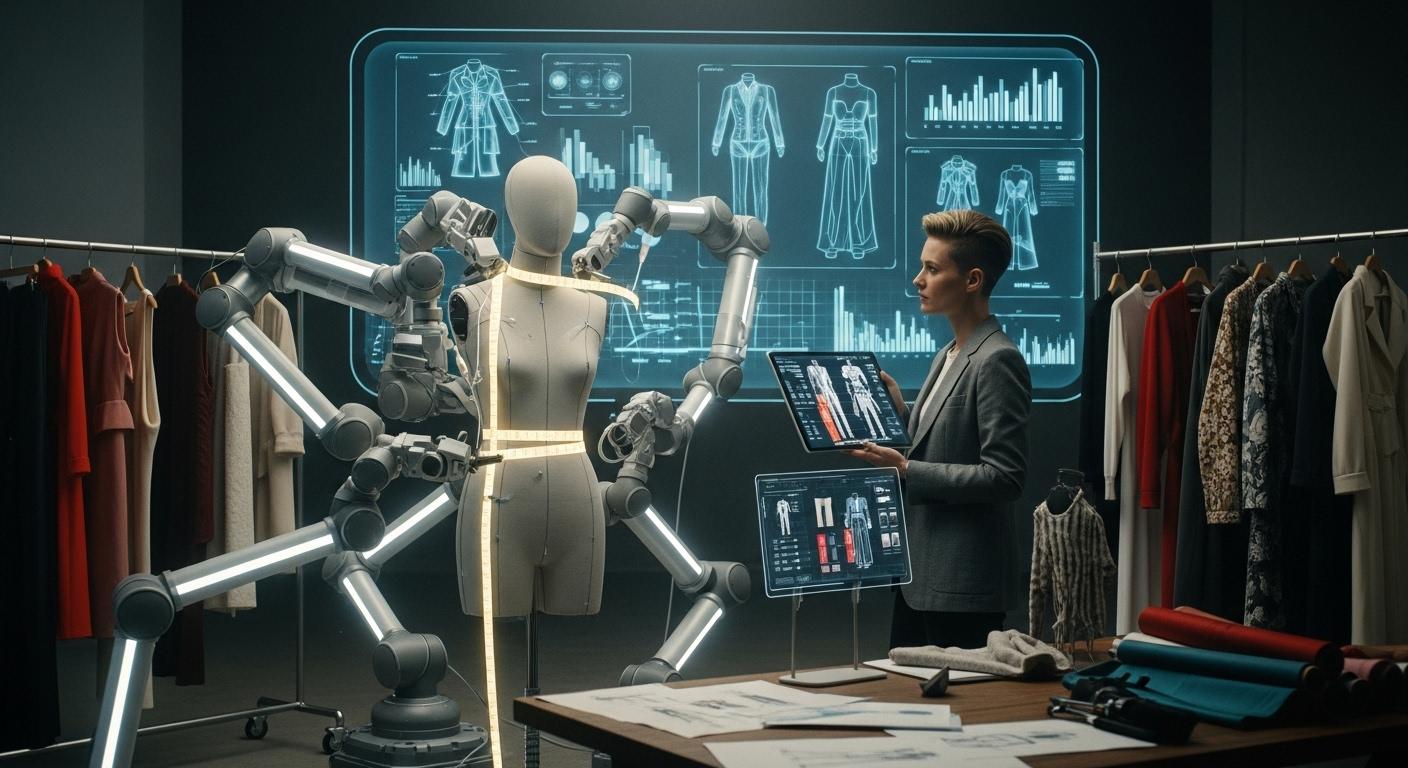
Machine learning is the primary driver behind the latest innovations in modular fashion. This technology enables modular dressing with interchangeable pieces, shaping the future of fashion. Artificial intelligence is central to this shift, as AI transforms fashion retail.
Note: The synergy between artificial intelligence and data is revolutionizing retail. This collaboration enhances everything from marketing and personalization to the core design of modular fashion.
Key applications in modular retail include:
- Retail Personalization: AI uses customer data for modular customization. This retail marketing data improves the customer experience for modular, interchangeable fashion.
- Modular Design: Artificial intelligence helps create modular designs. This fashion data helps predict trends, and the modular retail model uses this data for its marketing.
- Sustainable Retail: Machine learning optimizes modular fashion for sustainability. This process in retail makes the modular retail system work, using data to inform every modular design.
Core Machine Learning in Modular Fashion

Artificial intelligence provides the core engine for innovation in modular fashion. It processes vast amounts of data to forecast trends, generate new designs, and deliver deep personalization. This technology moves fashion beyond simple garments. It creates intelligent, interconnected modular systems. The following sections explore how specific machine learning applications are building the foundation for this new era in retail.
Forecasting Fashion Trends
Artificial intelligence excels at identifying emerging fashion trends. Machine learning algorithms analyze millions of data points from diverse sources. These sources include social media posts, runway show images, and retail sales data. This trend analysis allows brands to predict which colors, patterns, and silhouettes will become popular for individual modular pieces. This data-driven approach is central to modern retail marketing.
A company named Heuritech demonstrates this power. It uses artificial intelligence to scan over 3 million social media images every day. Its platform identifies thousands of fashion attributes. This process quantifies and predicts consumer demand for specific trends. This data helps brands align their products with market trends. It also reduces overproduction, which supports sustainability. Many major brands now use artificial intelligence for forecasting.
- H&M uses AI-driven models that incorporate sales data and social media trends. This practice helps the company align production with customer demand in its retail operations.
- Shein employs its own artificial intelligence to detect new trends in real-time. This triggers small-batch production, reducing waste and keeping its inventory fresh.
- Burberry integrates AI into its supply chain. The system monitors real-time demand signals to redistribute inventory, which optimizes stock levels across its retail network.
Generative Design for New Modules
Artificial intelligence does more than just predict trends; it actively helps create new modular designs. Designers use tools like Generative Adversarial Networks (GANs) and AI-CAD systems. In a GAN, two neural networks work together. One network, the generator, creates new designs. The second network, the discriminator, evaluates them against a set of data. This process results in novel yet compatible clothing modules. It ensures new interchangeable pieces maintain both aesthetic and functional coherence within a modular dressing system.
Note: The Fashion MNIST dataset includes items that are perfect examples of interchangeable pieces for modular dressing:
- T-shirt
- Dress
- Coat
- Pullover
- Shirt
- Trouser
This data allows artificial intelligence to learn the rules of fashion design. It can then generate countless new options for modular fashion, expanding the possibilities for customization. This is a core function of AI in fashion retail.
AI in Fashion Retail Personalization
Personalization is the ultimate goal of modular dressing. AI in fashion retail makes this possible on a massive scale. Recommendation engines are a key part of this customer experience. These systems use customer data, including body scans from virtual fitting rooms, style preferences, and purchase history. The AI analyzes this data to suggest compatible modular pieces. It can even assemble complete, personalized outfits from a user's existing and potential interchangeable pieces. This level of personalization transforms the retail journey.
This application of AI in fashion retail is not just theoretical. Many companies use artificial intelligence to enhance the customer experience and drive their marketing efforts. This personalized marketing helps customers navigate the world of modular fashion.
| Company | AI Application for Personalization |
|---|---|
| Nike | Employs a generative AI assistant to give tailored recommendations to over 170 million members, using data from browsing and purchase history. |
| Unspun | Uses its FitOS platform with advanced AI for precision fitting, analyzing body shape and posture to recommend specific garments. |
| Myntra | Utilizes AI in fashion retail to provide styling suggestions directly on its product pages, showing how a modular item can be worn. |
| Ajio | Recommends similar styles in its retail environment based on user browsing patterns, price filters, and cart data. |
This powerful use of data and artificial intelligence makes modular systems more accessible. It empowers consumers to build a wardrobe that is truly their own, piece by modular piece. The future of AI in fashion retail is about creating a dynamic and interactive relationship between the brand and the consumer.
The Broader Impact of Modular Dressing

The rise of modular fashion, powered by artificial intelligence, extends far beyond simple customization. This shift has profound effects on the entire fashion industry. It impacts everything from environmental sustainability to the very definition of a personal wardrobe. Artificial intelligence provides the data-driven intelligence needed to make this new model of fashion a reality in retail. This approach changes the customer experience and reshapes marketing strategies.
Promoting Fashion Sustainability
Modular dressing offers a powerful solution to the fashion industry's waste problem. The traditional model encourages frequent, disposable purchases. Modular fashion promotes a different mindset. Consumers buy fewer, high-quality interchangeable pieces that can be combined in many ways. Artificial intelligence helps optimize this process for sustainability. AI analyzes data on material durability and consumer usage patterns. This data helps brands create long-lasting modular components.
This focus on longevity and versatility directly counters the fast fashion cycle. It encourages sustainable practices by reducing the overall volume of clothing produced and discarded. Better marketing in retail can highlight these benefits.
This data-driven approach also minimizes overproduction. Brands use artificial intelligence to forecast demand for specific modular items with greater accuracy. This precision ensures they only produce what is needed. The result is less waste, a smaller carbon footprint, and a more responsible fashion ecosystem. This is a key goal for modern retail marketing.
The Hyper-Personalized Wardrobe
Modular dressing creates the ultimate personalization in fashion. Artificial intelligence is the engine that makes this possible on a large scale. AI systems analyze vast amounts of customer data to build a truly unique modular wardrobe for each user. Platforms like Stitch Fix use AI-driven stylists to suggest clothing combinations. These systems consider color preferences and past purchases to create hyper-personalized wardrobes. Stitch Fix even developed a generative AI tool called the Outfit Creation Model. This tool uses customer data and inventory data to generate outfit suggestions, improving the customer experience.
Many brands now use artificial intelligence to offer this level of customization.
- Nike By You allows customers to personalize sneakers by choosing colors and materials.
- Stitch Fix curates personalized clothing selections using its AI styling service.
- Unspun creates custom-fit jeans with 3D body scanning and AI-generated patterns.
- H&M has used AI-generated designs and smart fitting rooms to enhance its retail offerings.
AI algorithms learn a user's style by analyzing specific details. This learning process is continuous and becomes more accurate over time. The AI improves its recommendations based on data from past interactions.
- The system learns from user preferences for clothing styles, colors, or specific items.
- It analyzes details like necklines and silhouettes from items a user likes.
- It curates outfit combinations by learning from a user's previous choices.
- The AI considers style preferences, such as adding more oversized blazers if the user has favored them before.
Optimizing Connection Points
A successful modular fashion system depends on its connection points. The zippers, snaps, magnets, or buttons that hold interchangeable pieces together must be durable and easy to use. Artificial intelligence plays a crucial role in optimizing the design of these connectors. Engineers use machine learning models to analyze material stress data and predict potential failure points. This allows them to design stronger and more reliable modular attachments.
AI can also analyze user feedback data from reviews and returns. This data provides valuable insights into how customers interact with the interchangeable pieces. For example, if many users report difficulty with a certain type of clasp, the AI can flag this for designers. This feedback loop helps brands continuously improve the functional design of their modular clothing. A better connection system for interchangeable pieces enhances the entire modular dressing experience. This focus on quality is vital for retail success.
Ensuring Material Compatibility
A great modular outfit requires that different fabrics work well together. A heavy wool sleeve should not be paired with a delicate silk torso without careful consideration. Artificial intelligence helps ensure material compatibility within a modular system. AI systems can be trained on extensive data that includes fabric attributes like weight, texture, drape, and seasonality.
An AI-powered style advisor uses this data to make smart recommendations. The system extracts features from its data, including 'fabric' and 'color'. It then predicts user satisfaction with a potential outfit combination. While the AI does not physically test the textiles, its recommendations are based on data about which combinations work best. This ensures that every suggested modular combination is not only stylish but also comfortable and practical. This intelligent fitting process is a core part of the future of fashion retail and the modular dressing concept.
Artificial intelligence is redefining modular fashion. It uses data for predictive personalization and generative design. This technology optimizes how interchangeable pieces work together. The future of fashion is a versatile, personal wardrobe built through modular dressing. This shift benefits both the consumer and the retail industry. The retail marketing approach uses data to improve the customer experience in fashion retail. This retail model relies on data from retail operations.
Experts believe artificial intelligence will further transform fashion retail.
- AI models will empower everyone to become a fashion designer.
- AI will create a more interactive retail experience with personalized recommendations.
This synergy between artificial intelligence and modular dressing creates a new fashion retail system. It makes the consumer a co-creator in their style journey. This data-driven retail marketing makes fashion more dynamic and personal. The retail landscape for interchangeable fashion is changing.
FAQ
How does AI help create a personal style?
AI analyzes customer data like past purchases and style preferences. It then suggests compatible modular pieces. This process helps users build a unique wardrobe. The technology makes the retail experience more personal by learning a user's taste over time.
Is modular fashion better for the environment?
Yes, modular fashion promotes sustainability. People buy fewer, more versatile pieces. This reduces clothing waste. AI also helps brands predict demand accurately. This precision minimizes overproduction in the fashion industry, leading to a smaller environmental footprint for retail operations.
What is generative design in fashion?
Generative design uses AI to create new clothing ideas. A special type of AI, called a GAN, produces novel designs for modular parts. This technology ensures new pieces are both creative and compatible with existing items in a modular system.
How does this technology change fashion retail?
This technology shifts the focus of retail from mass production to mass personalization. It empowers consumers to become co-creators of their style. Brands use data to offer tailored suggestions, creating a more interactive and customized shopping experience for everyone.
See Also
Machine Learning: Predicting Fashion Trends to Significantly Boost Retail Sales
Forecasting Fashion Retail Trends: Advanced Predictive Models for 2025
Innovative AI Solutions: Sustainable Fashion for a Greener Global Future
AI's Role in Managing Rapid Viral Trends Within Fast Fashion
Achieving Equilibrium: Predictive Analytics Optimizes Fashion Supply And Demand